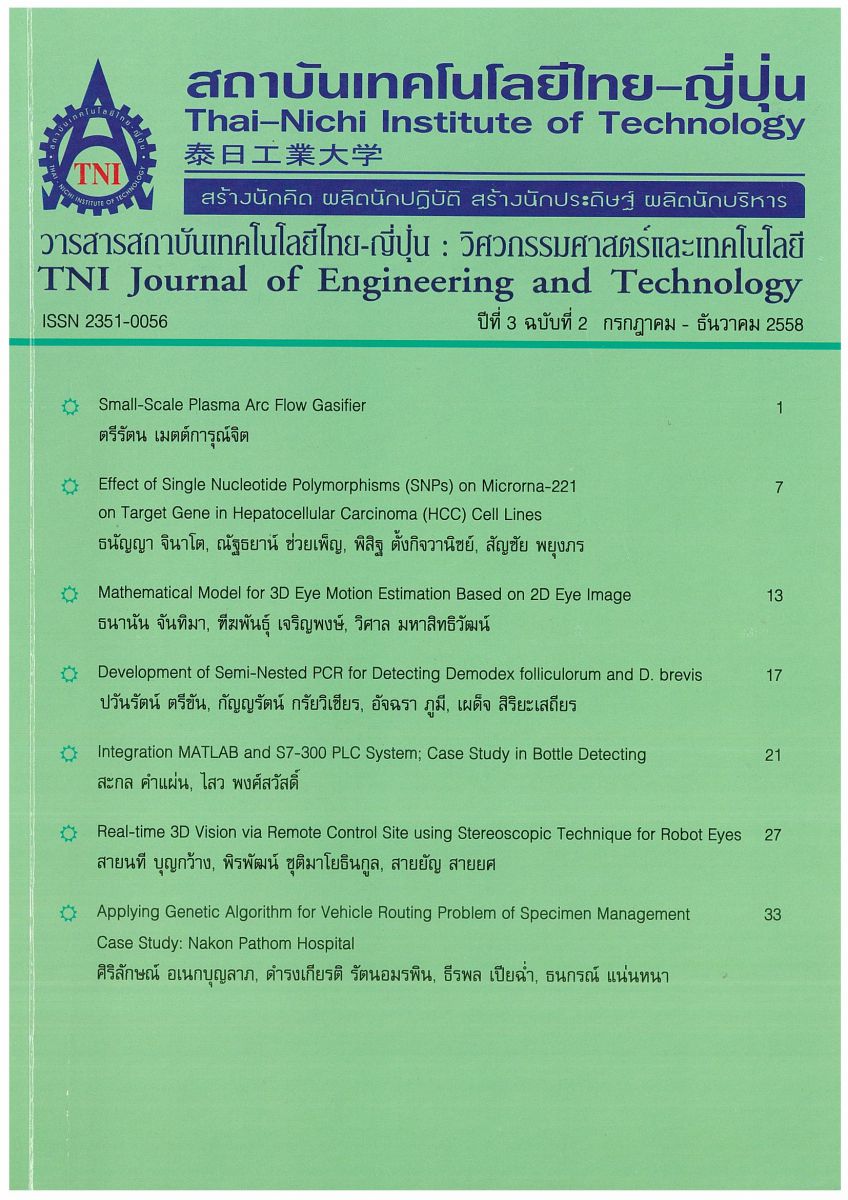Mathematical Model for 3D Eye Motion Estimation Based on 2D Eye Image
Main Article Content
Abstract
A challenge of current research concerning eye motion estimation in three-dimensional (3D) space is to estimate 3D eye motion from a two-dimension (2D) eye image. This paper proposed mathematic model using rotation matrix to estimate eye motion in 3D space from a 2D eye image. Eye movement is captured from two cameras mounting on an infrared binocular. A camera focuses on an eye. Data is recorded in image sequence format. This method consists of two steps: 1) formed 3D eye visual model 2)formed mathematical model. First, 3D eye visual model reconstructed from OpenGL libray. Eye is rotated between +50 degrees in two directions: yaw and pitch axis. Length of vertical and horizontal lines across the pupil are measured and used as indicator of eye rotation. Second, mathematic model is formed by using rotation matrix to rotate reference points to calculate the length of the two lines. Computational result of the two line is compared with the lengths from real eye rotation. To test the performance of proposed method, computational result will be compared with 3D eye visual model. Rotation angle is varied from +50 degrees in yew and pitch axis. The accuracy result of horizontal movement (Rex) and vertical movement (Rey) are 99.53% and 99.29% respectively. To evaluate 3D motion of2D real eye image, Computation result will be compared with 2D eye image and sent to rotate 3D eye visual model is be the same as 2D eye image. The advantage of this method is that eye motion in 3D space can be estimated from only one camera. The application of this method is to interpret the level of nystagmus disease in quality term.
Article Details
Article Accepting Policy
The editorial board of Thai-Nichi Institute of Technology is pleased to receive articles from lecturers and experts in the fields of engineering and technology written in Thai or English. The academic work submitted for publication must not be published in any other publication before and must not be under consideration of other journal submissions. Therefore, those interested in participating in the dissemination of work and knowledge can submit their article to the editorial board for further submission to the screening committee to consider publishing in the journal. The articles that can be published include solely research articles. Interested persons can prepare their articles by reviewing recommendations for article authors.
Copyright infringement is solely the responsibility of the author(s) of the article. Articles that have been published must be screened and reviewed for quality from qualified experts approved by the editorial board.
The text that appears within each article published in this research journal is a personal opinion of each author, nothing related to Thai-Nichi Institute of Technology, and other faculty members in the institution in any way. Responsibilities and accuracy for the content of each article are owned by each author. If there is any mistake, each author will be responsible for his/her own article(s).
The editorial board reserves the right not to bring any content, views or comments of articles in the Journal of Thai-Nichi Institute of Technology to publish before receiving permission from the authorized author(s) in writing. The published work is the copyright of the Journal of Thai-Nichi Institute of Technology.
References
F. Tombari, S.Mattoccia., L. D. Stefano and E. Addimanda, “Classification and Evaluation of Cost Aggregation Methods for Stereo Correspondence,” IEEE Conference on Computer Vision and Pattern Recognition (CVPR 2008), 2008, pp. 1-8.
H. C. Longuet-Higgind, “A computer algorithm for reconstructing a scene from two projections”, Nature, vol.239, 1981, pp. 133-135
Y. Y. Huang, M. Y. Chen, “3D Object Model Recovery from 2D Images Utilizing Corner Detection,” 2011 Internal Conference on system science and engineering (ICSSE 2011), Macau, China, 2011, pp. 76-81
S. Wibirama, S. Tungjitkusolmun, Ch. Pimtavirooj, and K. Hamamoto, “Dual Cameras Acquisition for Three-Dimensional Eye-Motion Tracking,” 2nd Biomedical Engineering International Conference(BMEiCON 2009), Thailand, 2009, pp. 126-130
S. Dong, “vision Measurement Method with Single Camera and 2-Axis Acclerometer Sensor,” 2013 4th International Conference on Intelligent Control and Information Processing (ICICIP), Beijing, China, 2013, pp. 25-29
Th. Charoenpong, P. Preeyanan, Ch. Theerasak and M. Visan, “Accurate Pupil Extraction Algorithm by Using Integrated Method,” 2013 5th Internation Conference on Knowledge and Smart Technology (KST2013), Thailand, 2013, pp. 32-37.
Th. Charoenpong, Sr. Thewsuwan, Th. Chanwimalueng and V. Mahasithiwat, “Pupil Extraction System for Nystagmus Diagnosis by Using K-Mean Clustering and Mahalanobis Distance Technique,” 4th lnt. Conf. on Knowledge and Smart Technology (KST), Thailand, 2012, pp: 24-29.
Th. Charoenpong, Sr. Thewsuwan, Th. Chanwimalueng and V. Mahasithiwat, “Accuracy Improvement of Pupil Extraction by Using Shape Estimation Algorithm,” Int. Workshop on Smart Info-Media System in Asia (SISA 2012), Thailand, 2012, pp: 33-38.


